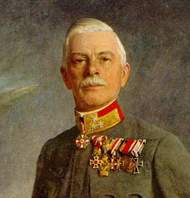 The land forces of the Austro-Hungarian monarchy were
essentially composed of three separate armies; the common army, which was
recruited from both the German and Hungarian portions of the empire, the
Austrian Landwehr, which was recruited from the so-called German provinces of
the empire, which in practice contained Poles, Ukrainians, Slovenians and Czechs
and the Hungarian Landwehr (Honvéd), recruited from the Hungarian administered
provinces of the empire. It should be stressed that the latter two organisations
were in no way second line or militia forces. Its members, like those of the
common army were either professionally enlisted soldiers or conscripts
performing their military obligation in the normal fashion. The existence of
three separate forces was a throwback to an earlier political decision of 1867
in which the right was conceded to the Hungarians to raise and maintain their
own armed forces. This force was known as the Hungarian Landwehr (Honvéd). A
similar balancing force was then raised in Austria and named the Landwehr. In
practice, during wartime all three forces fought side by side together, the only difference
actually being the nomenclature of the individual regiments. The regiments of
the common army were designated "Imperial and Royal" - kaiserlich und
königlich or k.u.k. The Austrian Landwehr regiments were titled "Imperial
Royal" - kaiserlich königlich or k.k. Finally the Landwehr (Honvéd) were
styled "Royal Hungarian" - königlich ungarisch or k.u. The land forces of the Austro-Hungarian monarchy were
essentially composed of three separate armies; the common army, which was
recruited from both the German and Hungarian portions of the empire, the
Austrian Landwehr, which was recruited from the so-called German provinces of
the empire, which in practice contained Poles, Ukrainians, Slovenians and Czechs
and the Hungarian Landwehr (Honvéd), recruited from the Hungarian administered
provinces of the empire. It should be stressed that the latter two organisations
were in no way second line or militia forces. Its members, like those of the
common army were either professionally enlisted soldiers or conscripts
performing their military obligation in the normal fashion. The existence of
three separate forces was a throwback to an earlier political decision of 1867
in which the right was conceded to the Hungarians to raise and maintain their
own armed forces. This force was known as the Hungarian Landwehr (Honvéd). A
similar balancing force was then raised in Austria and named the Landwehr. In
practice, during wartime all three forces fought side by side together, the only difference
actually being the nomenclature of the individual regiments. The regiments of
the common army were designated "Imperial and Royal" - kaiserlich und
königlich or k.u.k. The Austrian Landwehr regiments were titled "Imperial
Royal" - kaiserlich königlich or k.k. Finally the Landwehr (Honvéd) were
styled "Royal Hungarian" - königlich ungarisch or k.u. |